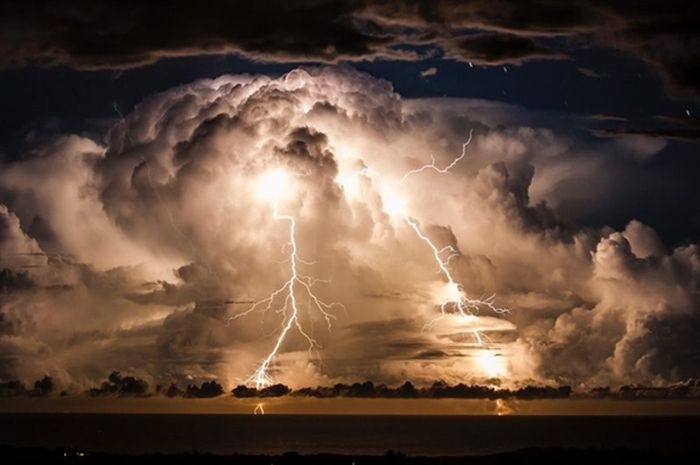Getty Images
–
Earth’s primordial atmosphere may have made it more difficult to produce lightning, new study says.
–
Nationalgeographic.co.id—When Earth formed 4.6 billion years ago from a hot mixture of gases and solids, it had almost no atmosphere. The surface is liquid. As the Earth cooled, the atmosphere formed mainly from gases spewed from volcanoes. This includes hydrogen sulfide, methane, and ten to 200 times more carbon dioxide than the current atmosphere. After about half a billion years, the Earth’s surface cools and is solid enough to hold the water above it.
Atmospheric conditions that continued to evolve at that time, apparently influenced the history of its formation lightning.
In 1952, Stanley Miller and Harold Urey made sparks fly in a tube filled with gas meant to reflect the composition earth’s atmosphere about 3.8 billion years ago. Their results suggest that lightning could lead to prebiotic molecules necessary for the evolution of life, such as amino acids.
At the same time, scientists thought the early atmosphere was methane and ammonia, but in the 1990s, scientists began to argue that the atmosphere was filled with carbon dioxide and molecular nitrogen.
Now, a new study published in the journal Geophysical Research Letters on February 10, 2022 entitled Streamer Discharges in the Atmosphere of Primordial Earthhave shown that the composition of Earth’s primordial atmosphere likely made conditions more difficult to produce lightning, which may also have increased the time required to generate and accumulate prebiotic molecules essential for life.

Peter Sawyer | Smithsonian Institution
–
When Earth formed 4.6 billion years ago, it had almost no atmosphere.
–
Electrons behave differently in an atmosphere made up of methane and ammonia versus an atmosphere made up mostly of carbon dioxide and molecular nitrogen. It stands to reason that lightning discharges would behave differently as well, so that could have influenced the possible formation of prebiotic molecules on early Earth. However several people have modeled how lightning discharge varies in different atmospheric environments.
To see how often electrons and gas molecules would collide in the two versions of the early Earth’s atmosphere, Christoph Köhn, a scientist at the National Space Institute at the Technical University of Denmark, who led the study modeled the probability of a spark discharge, the first step towards a lightning strike. They found that in a carbon dioxide-nitrogen atmosphere, it was more difficult to trigger the formation of lightning.
“Essentially, in an atmosphere rich in nitrogen and carbon, you need a stronger electric field to initiate the discharge,” Köhn said. Tech Explorist.
Also Read: Microbes and Minerals May Be Earth’s First Causes of Oxygenation
Also Read: The Atmospheric Pressure on Pluto’s Surface Is 80,000 Times Less Than Earth’s
Also Read: Exoplanet With Layered Atmosphere Like Earth Found
The model reveals that carbon dioxide and nitrogen atmospheres require about a 28% stronger electric field to release the precursor band of lightning, because gas molecules and electrons are less likely to collide and build up the electric charge that can produce a lightning strike.
This increase in space and time suggests there may have been fewer lightning strikes earlier in Earth’s history, making it less likely to produce prebiotic molecules.
“If lightning discharges are responsible for the production of prebiotic molecules, then it’s important to get a very good theoretical understanding of what’s going on,” said Köhn. “The big question remains, where do all these prebiotic molecules come from?” he added.
The study rigorously modeled the early stages of a lightning strike, in which sparks that start to strike are formed. So for Köhn and his colleagues, we will move on to the next step, which is to model the lightning strike as a whole and combine it with a chemical model of the atmosphere. It is hoped that together these studies can provide a more complete view of how lightning may have been linked to prebiotic molecules.
PROMOTED CONTENT
Featured Videos
–


